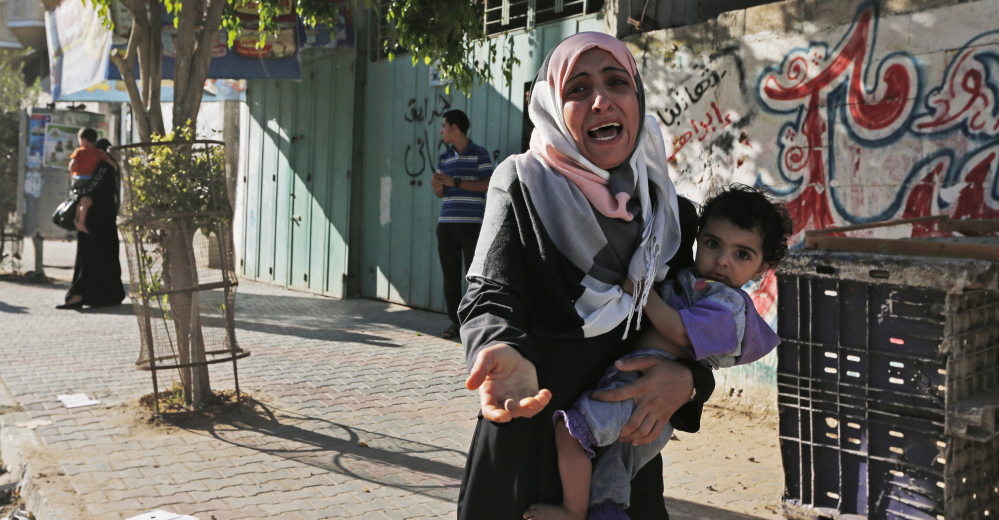GAZA CITY, Gaza Strip — The text message was as urgent as it was unwelcome: The Israeli army advised Mouin Ghaffir to leave his home quickly or risk being killed in airstrikes against Hamas rocket squads.
He swiftly sent his wife and 11 children to a dirty U.N. emergency shelter, with more than 40 people crammed in each classroom, but had to endure a night under bombardment at home after failing to find a safe place for his ailing 75-year-old mother.
Such is the life-and-death predicament of tens of thousands of Gazans being told by Israel to flee targeted areas, most with nowhere to go. U.N. shelters lack the space, and relatives, with their own overcrowded homes, often cannot help.
Israel says urging residents to evacuate – with warnings delivered through automated calls, text messages and leaflets dropped from planes – is part of the military’s attempt to spare civilians whenever possible.
It holds Hamas responsible for the ordeal of Gaza’s 1.7 million people, saying Hamas fighters fire rockets toward Israel from residential areas, effectively using civilians as human shields.
However, rights groups say simply sending warnings does not absolve Israel of responsibility and that those being urged to evacuate need somewhere to go.
In Ghaffir’s case, there was no way he could move his mother, Fawziyeh, after receiving the army’s text message late Tuesday. The elderly woman, afflicted by diabetes, high blood pressure and incontinence, needs constant care, he said. Conditions were chaotic in the U.N. girls’ school in a safer area where his wife Mona and their 11 children immediately sought refuge. But it was no place for his mother.
Instead, he moved her into the living room of the family’s home in the Shijaiyah neighborhood in eastern Gaza City, one of three areas Israel said it would target. Mother and son kept low to the ground, away from the windows.
“I didn’t sleep the entire night from the sound of the bombings,” said 48-year-old Ghaffir. “The walls were shaking and there was a crack in the wall.” He said the blasts shattered several windows in the house.
On Wednesday morning, Ghaffir moved his mother to his sister Leila’s apartment in an area deemed somewhat safer. But Leila, 65, had no room for the rest of his family, he said, noting that she lives in a one-bedroom apartment with her husband and four other family members.
After getting his mother out of Shijaiyah, where airstrikes continued Wednesday, Ghaffir joined his wife and children at the U.N. school. The classroom where his family slept the night before on a bare floor was filled with noisy children, but Ghaffir said he preferred the crowded conditions to being at home.
“Here, we are surrounded by people,” he said. “We get the feeling we are all together.”
Ghaffir’s story highlights the hard choices Gazans face in this war.
The Israeli army did not say how many homes it sent the warnings to, but the three areas – the town of Beit Lahiya and the sprawling Gaza City neighborhoods of Zeitoun and Shijaiyah – have a combined population of well over 300,000 people.
That’s far more than can be accommodated in U.N. schools, which cannot shelter more than 35,000. Currently, some 21,000 Gazans are crammed into 24 U.N. schools, said Sami Mshasha, a spokesman for the U.N. aid agency.
Moving in with relatives is not an option for most. While familial bonds tend to be strong in Gaza’s traditional society, families are large and – with a severe housing shortage – homes are crowded.
Copy the Story LinkSend questions/comments to the editors.



Success. Please wait for the page to reload. If the page does not reload within 5 seconds, please refresh the page.
Enter your email and password to access comments.
Hi, to comment on stories you must . This profile is in addition to your subscription and website login.
Already have a commenting profile? .
Invalid username/password.
Please check your email to confirm and complete your registration.
Only subscribers are eligible to post comments. Please subscribe or login first for digital access. Here’s why.
Use the form below to reset your password. When you've submitted your account email, we will send an email with a reset code.